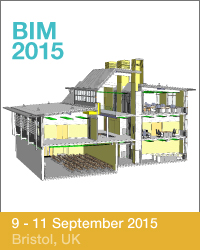BIM 2015
International Conference on Building Information Modelling (BIM) in Design, Construction and Operations
 9 - 11 September 2015
9 - 11 September 2015
Bristol, UK
Overview

The 1st International Conference on Building Information Modelling (BIM) took place at the University of the West of England, organised by that Institution and the Wessex Institute, and with the collaboration of Robert Gordon University, Aberdeen, Scotland.
The Conference was chaired by Professor Lamine Mahdjoubi of the University of the West of England, Bristol; Professor Carlos A Brebbia of the Wessex Institute; and Professor Richard Laing from Robert Gordon University, Aberdeen.
The conference discussed Building Information Modelling (BIM) as a catalyst for change in the twenty-first century. BIM is essentially value creating collaboration throughout the entire life-cycle of an asset, underpinned by the creation, collation and exchange of shared 3D models and intelligent, structured data attached to them. BIM has far reaching consequences on both building procurement and infrastructure. This recent emergence constitutes one of the most exciting developments in the field of the Built Environment. These advances have offered project teams multi-sensory collaborative tools and opportunities for new communication structures.
Modern built environment disciplines have been transformed through the development of new and innovative tools and techniques. These have fundamentally altered the manner in which the supply chain operates the processes through which designs are evolved, and the relationships between conceptual, detail, construction and life cycle stages.
The Conference fulfilled the vital task of bringing together experts from industry, practice and academia to debate topics, develop innovative solutions and predict future trends. The papers reflected this as well as the importance of interdisciplinary and collaborative practices. These papers are available to the international community through the eLibrary of Wessex Institute (www.witpress.com/elibrary) as well as the book, which is distributed internationally in paper and electronic format.
Opening of the Conference
Prof Paul Olomolaiye, Pro-Vice Chancellor of the University of the West of England, opened the meeting by explaining the role of Bristol in the historical development of the country, particularly in terms of engineering heritage. Bristol is now one of the most dynamic cities in the UK and a very pleasant place to live.
Bristol has the uniqueness that its Mayor is a professional Architect and an indication of the importance it attributes to its building environment is the fact that Bristol is now a Green European City.
The University itself – Paul explained – has the largest school of the Built Environment in the country with many fields of specialisation in its innovative curriculum.
Paul concluded that for all these reasons, the BIM Conference is very appropriate for the University and he wished all participants a successful week, during which further avenues of collaboration are found.
Prof Carlos A Brebbia, Director of WIT, welcomed the delegates in the name of his Institute and expressed his gratitude to the University for hosting the event.
Carlos explained that WIT’s objective was to act as a mechanism for the transfer of knowledge. The aim is to bring together colleagues from different fields to promote interdisciplinary activities.
WIT Conferences – Carlos said – are very international, as demonstrated by the many countries represented at this, as well as all other WIT meetings.
Research at the WIT Campus in the New Forest National Park focuses on the development of advanced computer codes which are currently used to solve complex engineering problems, particularly in industries such as energy and aerospace. This work is grounded in the research conducted over many years and the resulting tools are evolving continually to meet the demands of industry.
Of special interest to the conference participants is the work of WIT Press, the publishing arm of the Institute. It produces 50 or so books per year plus an increasing number of Journals.
The books include the Proceedings of Conferences, such as BIM. The papers are published in digital and paper format, and are widely distributed around the world. All of them are also archived in the digital library of the Institute at www.witpress.com/elibrary.
The Journals of the Institute which are relevant to BIM are the well-established International Journal of Sustainable Development and Planning and the newly launched International Journal of Energy Production and Management. Soon a further Journal will appear on the topic of Heritage Architecture. Carlos hoped that some of the participants would consider publishing enhanced versions of their papers in one of those Journals.
Carlos ended by wishing all a very successful conference and hoping that they will have the occasion to make new contacts and develop new projects. He also suggested that they consider visiting the WIT Campus when they are in the region, to obtain a better idea of the work carried out by WIT.
Prof Richard Laing from Robert Gordon University in Aberdeen explained the concept of BIM and how the conference encompasses a number of themes of an interdisciplinary character.
The design team is the whole of those participating in the construction. From single 2D CAD representations we have advanced to 3D information models. It is now the right time to work on integrated models appropriate to the end user demands.
The themes of the conference reflect this, ie
- Collaboration in sharing models
- Visualisation
- Data acquisition techniques
- Use of models during the construction phase
- Sustainability
- Information for existing buildings
The Conference themes are varied and original – Richard concluded – different from many other meetings on the same topic.
Prof Lamine Mahdjoubi referred to the importance of BIM from the “cradle to the grave”. It is not only necessary to construct a building but to consider how it will perform and the maintenance that it will require throughout its whole life, which includes decommissioning. Information, in other words, needs to be brought up to date.
Fundamental design decisions taken early in the design process have far reaching consequences. All the major mistakes are made on the first few days of the design process. Lamine explained that it is important to consider the following matters at an early stage:
- Constructability
- Environmental impact
- Operation and maintenance
The cost of design change continues to grow during the building programme while the ability to impact costs savings decreases.
BIM is also essential in safety planning as it fosters a collaborative approach to the problem. In the UK in particular health and safety is now considered an integral part of the project.
Architecture ought to be seen as a manufacturing process, Lamine said. There is currently a whole range of building components that are built in the factory rather than on site. BIM is affecting almost every aspect of design management, construction, operation and end of life.
Conference Topics
The papers presented at the meeting were divided into a series of topics, ie
- BIM collaborative working and practices
- BIM in design coordination
- BIM and life cycle project management
- BIM and automation in construction
- BIM in construction operations
- BIM-facilities management integration
- BIM in building operation and maintenance
- Interoperability issues and BIM
- BIM and sustainability
- BIM standards
- BIM-GIS integration
- BIM and cultural heritage
Inivted Presentations
A series of keynote addresses were part of the programme, ie
- “BIM: postgraduate multidisciplinary collaborative education” by Malachy Mathews, Dublin Institute of Technology, Ireland.
- “3D scene capture: a comprehensive review of techniques and tools for efficient Life Cycle Analysis (LCA)” by Lamine Mahdjoubi, University of the West of England, UK.
- “Scan to BIM: the development of a clear workflow for the incorporation of point clouds within a BIM environment” by Richard Laing, Robert Gordon University, Scotland, UK.
Conference Dinner
The Conference offered numerous opportunities for the delegates to interact outside the Conference room, during coffee and working lunch breaks. This was helped by having all these functions taking place just outside the Conference rooms.
The Conference dinner took place in the unusual setting of a barge moored on the river bank in the centre of town. It has been converted into an excellent restaurant with good wines and friendly service. The dinner was most successful and contributed to strengthen links amongst the delegates.
Closing of the Conference
Carlos closed the conference by thanking all delegates for their participation and stressing the success of the meeting. He explained that the success of the Conference has led the organisers to reconvene it in two years’ time. This will take place at the University of Alicante, Spain from 10-12 May 2017. For further information please contact WIT
Conference Proceedings
The proceedings of BIM 2015 - Building Information Modelling (BIM) in Design, Construction and Operations, 626pp (Print ISBN: 978-1-84564-914-2; eISBN: 978-1-84564-915-9) are available from WIT Press. Orders can be placed on the WIT Press web site at www.witpress.com or by email:
Papers from the conference will also be hosted online at the WIT eLibrary in Volume 149 of WIT Transactions on the Built Environment (ISSN: 1746-4498 Digital ISSN: 1743-3509). For more details visit the WIT eLibrary at http://witpress.com/elibrary
Related conferences
- BIM 2017, Alicante, Spain, 10 - 12 May, 2017
- Eco Architecture 2016, Alicante, Spain, 13 - 15 July 2016
- Sustainable City 2016, Alicante, Spain, 12 - 14 July 2016
- Design & Nature 2016, New Forest, UK, 13 - 15 September 2016
- Sustainable Development and Planning 2016, Penang, Malaysia, 6 - 8 December 2016


 Wessex Institute
Wessex Institute